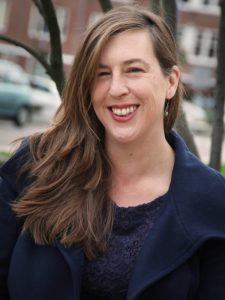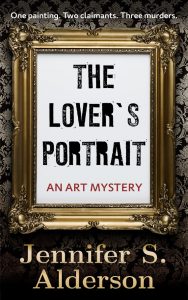How Archival Research Added Texture To My Novel
 Let me make this clear from the start: I love the smell and feel of archival documents, those yellowing bits of paper and crumbling photographs that rustle ever so slightly when extracted from their manila envelopes.
Let me make this clear from the start: I love the smell and feel of archival documents, those yellowing bits of paper and crumbling photographs that rustle ever so slightly when extracted from their manila envelopes.
There’s something magical about scouring through meters of racks, drawers and file folders until you find an interesting or odd snippet of information recorded long ago which helps a character or story truly come to life.
While working out the storyline for my second novel, The Lover’s Portrait, I realized early on that the restitution of looted artwork and the treatment of Jewish citizens in the 1930s and 1940s, were going to be central to the plot.
To ensure that any potentially controversial aspects of my art mystery were honestly and accurately described, extensive archival research would be essential. What I didn’t expect, is that this same research would add much needed texture and depth to my story, infuse it with universal themes and – according to all the reviewers so far – be what sets it apart.
I knew one of the main characters was going to be an art dealer being blackmailed by a Nazi general during the Second World War. I just didn’t know exactly why he would be forced to give up his collection.
Restitution of art was a topic already very familiar to me, one I’d learned much about during art history and museum studies lectures at the University of Amsterdam. However the details surrounding important events in Dutch history, and the attitudes held in Europe during that period, were not.
It was crucial for the plot that this art dealer character not be Jewish, but did need to be considered a ‘dissident’ or threat to the Nazi regime for another reason. I went to the Amsterdam City Archives with an open mind and list of questions.
I’d thought up all sorts of plot twists which involved other groups targeted by Hitler’s troops – Roma’s, communists, Jehovah’s Witnesses, political dissidents and homosexuals – and decided to see what my adopted hometown’s archives could tell me about how they were affected by the war.
The documents I found relating to the treatment of homosexuals were the least known, and therefore most interesting, to me. Before visiting the archives, I’d read several non-fiction books to better understand this turbulent time in European and Dutch history, and seen no mention of how Dutch men could be arrested, castrated and sent off to work camps in Germany based on the mere suspicion that they were homosexual.
Or that lesbians were classified as ‘political dissidents’ in work camps. That’s when I realized I’d found a ‘winner’ qua topic, one which hadn’t already been exhaustively explored in mainstream literature.
The sensitive nature of the themes discussed in this novel warranted that it be historically accurate, yet it was never my intention to write a historical fiction novel, but an art-infused mystery. When my ‘final draft’ clocked in at 110,000 words, I was afraid it was too long or would only appeal to historical fiction buffs, so I slashed many of the chapters which relied heavily on the obscure details I’d worked so hard to find.
The end result was shorter and less historical, but without all those enticing tidbits of information to fill in the characters’ backgrounds or help explain plot developments, the whole story fell flat. It was as if I’d ripped the soul out of my novel.
Despite my misgivings about the length, I added everything back in and even wrote three new chapters taking place in wartime Amsterdam to provide more depth and richness to the story, choosing to edit down the present day sections of the book to compensate. Man, am I glad I did! It’s the research that grabs reviewers’ attention, enhanced their enjoyment of the story and characters, and seems to be what distinguishes this novel from others in the ‘amateur sleuth’ category.
 My research has also paid off in other ways. Last week, I found out the Jewish Historical Museum in Amsterdam is adding The Lover’s Portrait to their library’s permanent collection because they are thrilled with their prominent role in the book.
My research has also paid off in other ways. Last week, I found out the Jewish Historical Museum in Amsterdam is adding The Lover’s Portrait to their library’s permanent collection because they are thrilled with their prominent role in the book.
The Stedelijk Museum in Amsterdam has already added it to their library based on the merits of my research into the complexities surrounding the restitution of looted artwork. And a prominent local LGBT organization, Pink Point, is helping me promote the book here in the city because they believe the storyline to be unique.
Yes, I spent many long hours browsing through often useless documents, pamphlets, flyers and photographs in far-flung physical and digital archives. I didn’t have to. But without all of the little details adding texture, depth and layers of meaning, my book wouldn’t have been the same. And frankly, I enjoyed every second of it!
Fellow authors, do you conduct archival research in order to add texture to your fiction? Readers, do you expect fiction to be well-researched, or are you just as happy to step into a completely fictitious world?
—
Jennifer S. Alderson was born in San Francisco, raised in Seattle and currently lives in Amsterdam. Her love of travel, art and culture inspired her on-going series of novels following the adventures of Zelda Richardson around the globe.
In her first book, Down and Out in Kathmandu: Adventures in Backpacking, Zelda goes to Nepal to volunteer as an English teacher in Kathmandu, where she gets entangled with an international gang of smugglers whose Thai leader believes she’s stolen their diamonds.
The Lover’s Portrait: An Art Mystery follows Zelda to Amsterdam, where she discovers clues to the whereabouts of a cache of missing masterpieces buried somewhere in the city, hidden away in 1942 by an art dealer who’d rather die than turn his collection over to his Nazi blackmailer. Her third novel – another art-related mystery centered around Papua New Guinean ‘bis poles’, missionaries and anthropologists – will be released in the summer of 2017.
http://www.jennifersalderson.c
http://www.facebook.com/jennif
Category: Contemporary Women Writers, How To and Tips
Comments (7)
Trackback URL | Comments RSS Feed
Sites That Link to this Post
- How Much Research Should You Do? | June 6, 2017
- Guest post on Women Writers, Women’s Books – Jennifer S. Alderson | December 23, 2016
























Your writing journey is fascinating. I thoroughly enjoyed reading this. I am delighted you are in the Handbag Gallery!
Thank you, Jessie! I am so glad you enjoyed learning more about my journey and books. And I am honored to be in your wonderful gallery 🙂 Book Three is coming out in March; I’ll have to find a bigger handbag!
This article has me eager to read your books, Jennifer!
For me, research and well-woven, accurate historical detail elevates any novel, crucial in creating plausible and intriguing stories.
Thanks for this, Books By Women and Jennifer Alderson ~
Anna
How lovely to hear, thank you Anna Herrington! I love your remark as well, so well put. It is the little details that make the difference. If you end up reading The Lover’s Portrait, I do hope you enjoy it. Happy 2017!
Thank you for featuring this article on your wonderful website!